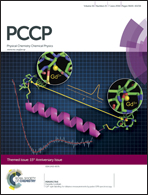Construction of a metal–organic monolayer–semiconductor junction on a hydrogen-terminated Si(111) surface via Si–C covalent linkage and its electrical properties†
Abstract
A metal–organic monolayer–semiconductor junction, exhibiting a diode behaviour, was constructed on a hydrogen-terminated n-type Si(111) by sequential surface reactions of (1) formation of an organic monolayer with a thiol terminal group, (2) platinum deposition onto the thiol group via adsorption of a platinum complex followed by chemical reduction, and finally (3) continuous Ag layer formation by electroless deposition. Rectifying behaviour was observed at this interface.

- This article is part of the themed collection: PCCP’s 15th anniversary

 Please wait while we load your content...
Please wait while we load your content...